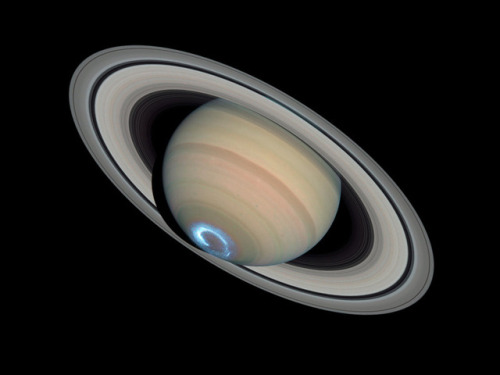Why The Fuck Would You Taste It?!
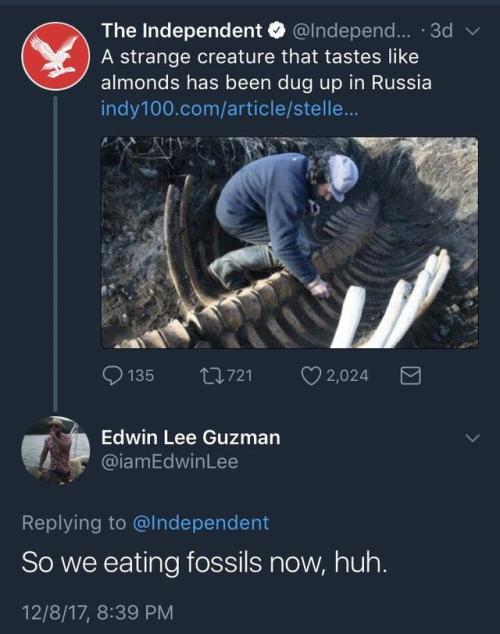
Why the fuck would you taste it?!
More Posts from Saients and Others
lab partner: *hands me precisely 1 mole of a substance*
me: *vine voice* an avogadro!!! thanks!!


The Drake Equation
In 1961, following an early SETI experiment using radio telescopes called Project Ozma, astronomer Frank Drake arranged a historic meeting at the National Radio Astronomy Observatory in Green Bank, West Virginia. The ten attendees - among them a young Carl Sagan - discussed the feasibility and methodology of detecting extraterrestrial civilizations using radio astronomy. They formulated the Drake Equation - a rough, speculative means of estimating the possible number of current technologically-advanced civilizations in the galaxy.
N = the number of advanced extraterrestrial civilizations potentially detectable by radio signals in the Milky Way Galaxy.
Depending on the values used for each variable, N can work out to be hundreds of thousands or more, or very few.
R* = Rate of new star formation.
One estimate is 7 stars per year.
Fp = Percentage of stars with planetary systems around them.
New solar systems are being discovered every year.
Ne = Number of planets per star system capable of sustaining life.
Depending upon the temperature, type, and size of the star, the habitable zone of a planet for Earth-like life may be nearer or further from its star. Based on our own solar system, we might guess 1 or 2.
Fl = Fraction of those planets upon which life appears.
How many of those habitable planets upon which life has developed is difficult to estimate. In our own solar system, it’s at least 1 - there is a good chance that at one point, life developed on Mars, though traces of it have yet to be found.
Fi = Fraction of those planets where intelligent life appears.
Estimates vary wildly. We know it’s happened at least once here on Earth. As ‘intelligence’ is subjective, it may be that it has developed in other non-human, communicating species, like whales.
Fc = Fraction of those societies that develop advanced communication technology and send signals into space.
Intentional or unintentional, other civilizations might transmit identifiable signals into outer space that modern Earth technology could pick up.
L = Lifetime of communicative civilizations.
Do technologically-capable civilizations inevitably self-destruct, or can they last forever? This is an immensely uncertain question. We’ve been communicating with radio waves for fewer than 100 years, with the long-term survival of our species and our status as ‘technological’ uncertain.










Newest LIGO Signal Raises A Huge Question: Do Merging Black Holes Emit Light?
“The second merger held no such hints of electromagnetic signals, but that was less surprising: the black holes were of significantly lower mass, so any signal arising from them would be expected to be correspondingly lower in magnitude. But the third merger was large in mass again, more comparable to the first than the second. While Fermi has made no announcement, and Integral again reports a non-detection, there are two pieces of evidence that suggest there may have been an electromagnetic counterpart after all. The AGILE satellite from the Italian Space Agency detected a weak, short-lived event that occurred just half a second before the LIGO merger, while X-ray, radio and optical observations combined to identify a strange afterglow less than 24 hours after the merger.”
Whenever there’s a catastrophic, cataclysmic event in space, there’s almost always a tremendous release of energy that accompanies it. A supernova emits light; a neutron star merger emits gamma rays; a quasar emits radio waves; merging black holes emit gravitational waves. But if there’s any sort of matter present outside the event horizons of these black holes, they have the potential to emit electromagnetic radiation, or light signals, too. Our best models and simulations don’t predict much, but sometimes the Universe surprises us! With the third LIGO merger, there were two independent teams that claimed an electromagnetic counterpart within 24 hours of the gravitational wave signal. One was an afterglow in gamma rays and the optical, occurring about 19 hours after-the-fact, while the other was an X-ray burst occurring just half a second before the merger.
Could either of these be connected to these merging black holes? Or are we just grasping at straws here? We need more, better data to know for sure, but here’s what we’ve got so far!
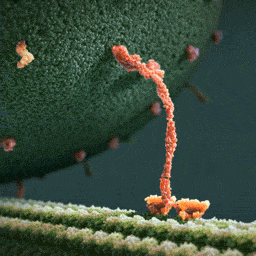
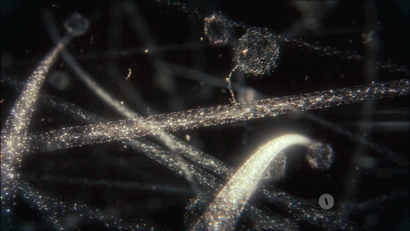
Your body is an incredibly bizarre machine.
“What you see is a myosin protein dragging an endorphin along a filament to the inner part of the brain’s parietal cortex which creates happiness. Happiness. You’re looking at happiness.”
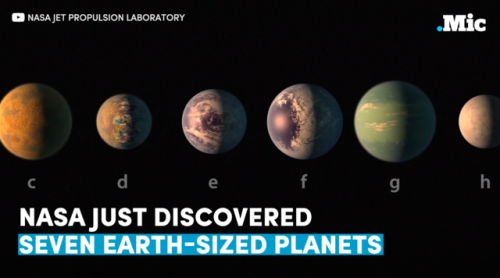
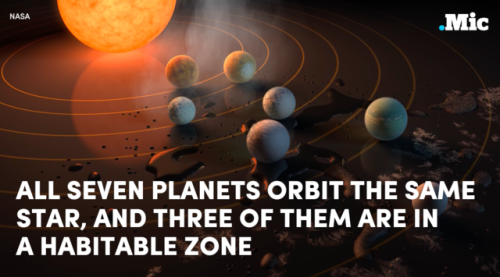

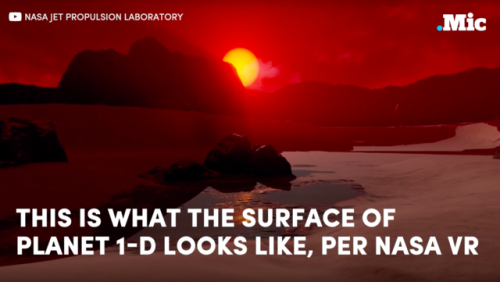
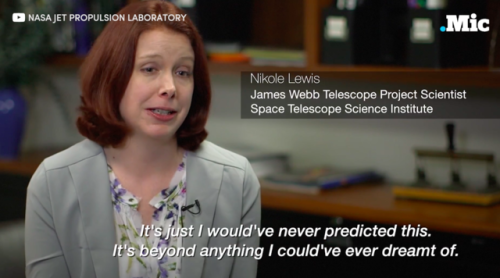
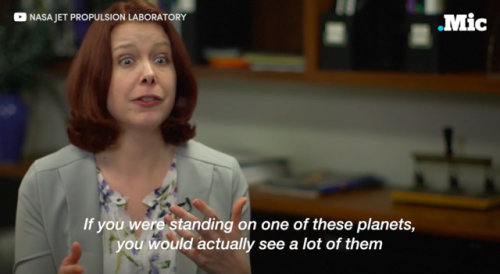
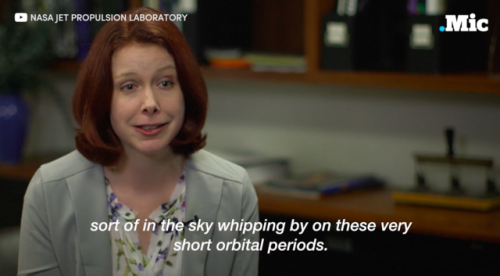
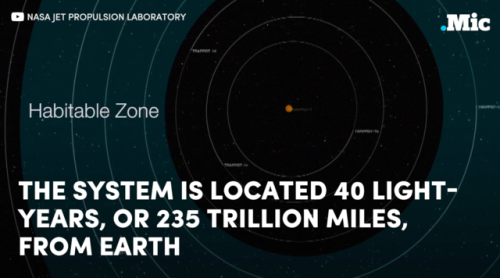
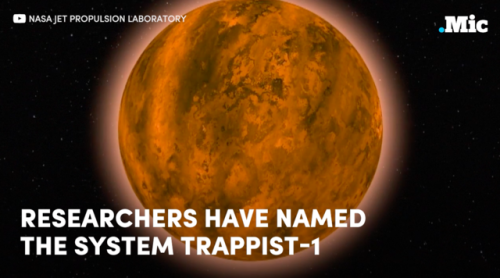
According to NASA, a neighboring star has 7 Earth-like planets in its orbit
Seven Earth-like planets have been found orbiting a sun not too far — in space terms, at least — from our own.
NASA announced Wednesday that the planets resemble Earth in composition and spacing from their star, which means their conditions might be favorable to liquid water and life, Time reported.
“The planets form a very compact system,” Michaël Gillon of Belgium’s University of Liège, said in a teleconference, according to Time. “They are very close to their star and are reminiscent of the system of moons that orbit Jupiter. They could have liquid water and life.”
Astronomers studied the star, Trappist-1 — which, at 39 light years away from Earth, is considered a relative neighbor — for six years, using telescopes located all over the world, plus the Spitzer Space Telescope. Read more (2/22/17 2:04 PM)
follow @the-future-now

hey guys!! it has been a while :’))
however, i have finished my first semester of chemistry (pre-ib) and i felt as if that i did pretty well in this subject even though i had minimal background knowledge on it. i initially struggled with the concepts we did, but after studying hard and trying my best i have gotten used to it and have been improving so here are my tips and tricks for chemistry!
please understand that i have not been through all the topics in chemistry, i have only learnt about atomic structure, periodicity and bonding so my links and tips may only help you for those topics but they should help with the other topics also. (this is most likely a general chemistry masterpost btw)
important study tips:
ask questions in class!!!!!! this is incredibly important, as also for every subject but if you don’t understand the concept you will struggle like how i did in the beginning :( if you are too shy to ask your question in front of the class, go up to the teacher when you have some time or even email them. even just ask your friends or classmates who may have a better understanding of the concept, it definitely helps having different explanations on the same topic, having different perspectives and all
find good resources, go through past tests, past exams and worksheets so that you can have good practice of what may come in your tests and exams. my teacher was very organised and had plenty of resources for me to use to revise and learn in my spare time out of class. it also gave me the experience of the ib tests and exams so i knew what was to come
as said in my maths masterpost, try teaching others when they need help (if you understand the topic and they don’t) because this really seems to help me when studying for tests, i helped my friend with her questions about atomic structure and found myself learning and revising at the same time because of this
repetition!!! you may not get it right the first time, or even the second, but after lots of tries and times you will get there!! trust me :’))
if you don’t have resources, go search for some. there are plenty of studyblrs who do chem as a subject and im sure they are more than happy to help you (me too but i haven’t through many of the topics lol) once you have been through all the past papers you own, go google for some, especially ib kids, theres some out there for you!
have a periodic table with you at all times when studying chem! its a bit obvious but you would most likely need it
apps + websites:
periodic table apps (there is loads on the app stores but here are some i found)
periodic table [ android | ios ] very indepth and informative (glad i just found this one, im downloading it rn)
periodic table (this one is different) [ android | ios ]
there is plenty, so find the app which suits you and your learning needs
molview (this website allows you to draw molecules!!)
ibchem.com for my fellow ib chem students, this website has notes and other resources to help you with your studies
2016 ib data booklet (there is probably going to be a 2017 one soon but anyways this will be useful
khan academy chemistry (honestly this website is a blessing to all students, so helpful !!!!)
sparknotes chem
other chemistry masterposts:
chemistry by @areistotle
ap chemistry by @etudiance
chemistry resource masterpost originally by @physicnerd
general chemistry masterpost by @ellielearnsthings
my other masterposts:
chinese masterpost
app masterpost
bullet journaling
maths masterpost
advice for new studyblrs
physics masterpost
i hope that these resources and tips will help you in your chemistry studies c:
studygram: acadehmic

The tail of a 99-million-year-old dinosaur, including bones, soft tissue, and even feathers, has been found preserved in amber, according to a report published today in the journal Current Biology.

A micro-CT scan of the delicate feathers that cover the dinosaur tail. Image: Lida Xing.
While individual dinosaur-era feathers have been found in amber, and evidence for feathered dinosaurs is captured in fossil impressions, this is the first time that scientists are able to clearly associate well-preserved feathers with a dinosaur, and in turn gain a better understanding of the evolution and structure of dinosaur feathers.
We clearly need a new Jurassic Park movie featuring cute feathery dinosaurs.

A reconstruction of a small coelurosaur Credit: Chung-tat Cheung

As a paleo-artist, one of my biggest pet peeves are prehistoric whales reconstructed not as whales but as sinewy, snarling, shrink-wrapped marine reptiles. It’s just not a plausible reconstruction, even if it’s highly speculative, and it paints an incorrect image in the public eye. Granted, this is a struggle I’ve exlpored in all forms of paleo-art and reconstructive illustration. But the whales have really been getting to me recently.
Here are some recontructions of Basilosaurus, if you don’t know what I mean (one by Karen Carr, the other by an artist I could not determine):


These snakey, reptilious reconstructions may stem from the fact that Basilosaurus, one of the first early cetaceans to be found, was believed to be a reptile when first discovered (hence the name). Maybe we simply haven’t fully shaken that mindset.
But still! Even the damn Smithsonian, which has such a wonderful collection of ancient cetaceans, is at fault in this:

Don’t even get me started on their recently-closed dinosaur hall. Thank the lord they’re finally renovating that dated piece of crap.
I have struggled to find a way to reconstruct these animals so that they are just a little bit more believeable. Up top I’ve done a really really quick sketch of Dorudon. I tried to not only make its body more streamlined and whale-like (because Dorudon has a lovely, almost but not quite modern-looking skeleton), but I also tried to give it markings similar to what we find on modern cetaceans for camouflage. Because hey, who’s to say they didn’t have ‘em? I tried to make them familiar but not directly copied from any modern species.
Aaaaand end rant.
The Shepard-Risset Glissando
A Shepard tone, named after Roger Shepard, is a sound consisting of a superposition of sine waves separated by octaves. When played with the base pitch of the tone moving upward or downward, it is referred to as the Shepard scale. This creates the auditory illusion of a tone that continually ascends or descends in pitch, yet which ultimately seems to get no higher or lower. It has been described as a “sonic barber’s pole”.
Jean-Claude Risset subsequently created a version of the scale where the tones glide continuously, and it is appropriately called the continuous Risset scale or Shepard–Risset glissando. When done correctly, the tone appears to rise (or descend) continuously in pitch, yet return to its starting note. Basically, it’s a continuously descending tone that never gets any lower. It’s the acoustical version of M.C. Escher’s Penrose Stairs optical illusion. Source.
Doesn’t it sound a little bit creepy?
-
 distracteddaintydemon liked this · 2 weeks ago
distracteddaintydemon liked this · 2 weeks ago -
 tiniestapocalypse reblogged this · 2 weeks ago
tiniestapocalypse reblogged this · 2 weeks ago -
 thequabblemeister liked this · 3 weeks ago
thequabblemeister liked this · 3 weeks ago -
 a-star-ixx liked this · 1 month ago
a-star-ixx liked this · 1 month ago -
 multifandomgenius-blog reblogged this · 1 month ago
multifandomgenius-blog reblogged this · 1 month ago -
 leodoriya liked this · 2 months ago
leodoriya liked this · 2 months ago -
 ivorymoons-stuff reblogged this · 2 months ago
ivorymoons-stuff reblogged this · 2 months ago -
 ivorymoons-stuff liked this · 2 months ago
ivorymoons-stuff liked this · 2 months ago -
 nychtatromos liked this · 2 months ago
nychtatromos liked this · 2 months ago -
 rhilumi liked this · 2 months ago
rhilumi liked this · 2 months ago -
 soarrenbluejay reblogged this · 2 months ago
soarrenbluejay reblogged this · 2 months ago -
 soarrenbluejay liked this · 2 months ago
soarrenbluejay liked this · 2 months ago -
 y1ppl3 liked this · 2 months ago
y1ppl3 liked this · 2 months ago -
 motherfuck-why reblogged this · 2 months ago
motherfuck-why reblogged this · 2 months ago -
 arandomao3user reblogged this · 2 months ago
arandomao3user reblogged this · 2 months ago -
 arandomao3user liked this · 2 months ago
arandomao3user liked this · 2 months ago -
 838099 reblogged this · 2 months ago
838099 reblogged this · 2 months ago -
 choco-maki-mallows liked this · 2 months ago
choco-maki-mallows liked this · 2 months ago -
 r4d104ct1vef0l146e reblogged this · 2 months ago
r4d104ct1vef0l146e reblogged this · 2 months ago -
 r4d104ct1vef0l146e liked this · 2 months ago
r4d104ct1vef0l146e liked this · 2 months ago -
 digitalmeowmix liked this · 2 months ago
digitalmeowmix liked this · 2 months ago -
 disco-wyrm liked this · 3 months ago
disco-wyrm liked this · 3 months ago -
 thetrashking-silver reblogged this · 3 months ago
thetrashking-silver reblogged this · 3 months ago -
 weepin-willo liked this · 4 months ago
weepin-willo liked this · 4 months ago -
 martianwitch129 liked this · 4 months ago
martianwitch129 liked this · 4 months ago -
 lost-particle reblogged this · 4 months ago
lost-particle reblogged this · 4 months ago -
 niranutcake liked this · 4 months ago
niranutcake liked this · 4 months ago -
 puppybotz liked this · 5 months ago
puppybotz liked this · 5 months ago -
 ewoobutnooriginalcontent reblogged this · 5 months ago
ewoobutnooriginalcontent reblogged this · 5 months ago -
 ewoo liked this · 5 months ago
ewoo liked this · 5 months ago -
 pannyexpress liked this · 5 months ago
pannyexpress liked this · 5 months ago -
 gwolfkate liked this · 6 months ago
gwolfkate liked this · 6 months ago -
 gwolfkate reblogged this · 6 months ago
gwolfkate reblogged this · 6 months ago -
 tiny-cat reblogged this · 6 months ago
tiny-cat reblogged this · 6 months ago -
 nommeliivatee reblogged this · 6 months ago
nommeliivatee reblogged this · 6 months ago -
 thetrashyghost reblogged this · 6 months ago
thetrashyghost reblogged this · 6 months ago -
 omniscientrose liked this · 6 months ago
omniscientrose liked this · 6 months ago -
 skchorpion reblogged this · 6 months ago
skchorpion reblogged this · 6 months ago -
 theobsessedone reblogged this · 6 months ago
theobsessedone reblogged this · 6 months ago -
 theobsessedone liked this · 6 months ago
theobsessedone liked this · 6 months ago -
 lukino reblogged this · 6 months ago
lukino reblogged this · 6 months ago -
 lukino liked this · 6 months ago
lukino liked this · 6 months ago -
 foreverinlovewithbooks liked this · 6 months ago
foreverinlovewithbooks liked this · 6 months ago -
 slowedclover4 liked this · 6 months ago
slowedclover4 liked this · 6 months ago -
 milverton reblogged this · 6 months ago
milverton reblogged this · 6 months ago -
 hermit-hedge liked this · 6 months ago
hermit-hedge liked this · 6 months ago -
 weiserthanyou liked this · 6 months ago
weiserthanyou liked this · 6 months ago
Stardate: 2258.42...or, uh, 4... Whatever. Life is weird, at least we've got science.
75 posts
